When cycling, your shoes are an important accessory that enhance comfort, control, and efficiency, and finding the best road bike shoes can help elevate your experience and performance. As a critical interface between you and your road bike, the importance of quality, well-fitting footwear should absolutely not be overlooked.
Whether you’re a novice, weekend warrior, or aspiring racer, the right pair of road bike shoes not only look good but help you perform at your best. Stiff soles and a secure fit provide stability and efficient transfer of power into the pedals while supple uppers and quality closures offer snug, glove-like fits, and all-day comfort.
With so many models on the market to choose from, it can be a daunting task to wade through the marketing lingo and specs to find the right pair of road bike shoes that meets your needs. To help, we gathered up a selection of the best road shoes on the market to test and compare side by side while analyzing the design and important performance characteristics like fit, comfort, pedaling efficiency, and ventilation.
Our top-rated picks are listed below, but if you’d like to quickly compare specs at a glance be sure to reference our comparison chart. If you need help deciding what to buy, check out our detailed buying advice or FAQ section for answers to your questions.
Editor’s Note: We updated this review on Feb 21, 2024, with the addition of the Pearl Izumi PRO Air and Giro Imperial shoes to our selection, and checking to ensure that the rest of the products and information provided are as up-to-date as possible.
The Best Road Bike Shoes of 2024
- Best Overall Road Bike Shoes: Rapha Pro Team
- Best Budget Road Bike Shoes: Giro Cadet
- Runner-Up Best Budget Road Bike Shoes: Bontrager Circuit
- Runner-Up Best Road Bike Shoes: Specialized S-Works Torch
- Best Road Bike Shoes For Racing: Shimano S-Phyre RC9
- Best Ventilated Road Bike Shoes: Pearl Izumi Pro Air
- Best Lace-Up Road Bike Shoes: Rapha Classic
Rapha Pro Team Shoes
Specs
- MSRP $380
- Weight 250g (size 42)
- Upper Material 3D woven Powerweave with DWR
- Outsole Full-length carbon
- Closure System Dual Boa IP1 dials
- Available Colors White, Black, Green/Grey Blue/Teal, High-Vis Pink
- Available Sizes Full: 36-47, Half: 40-46
- Cleat Compatibility 3-bolt road

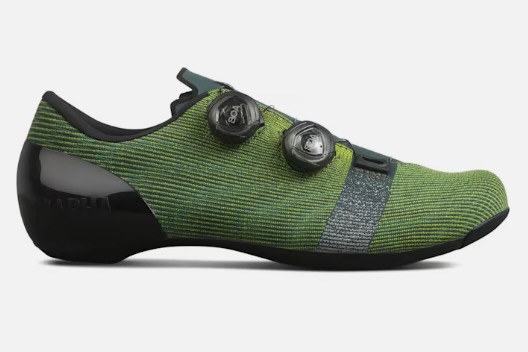
Pros
- Gorgeous looks with minimal branding
- Goldilocks width in forefoot
- Natural fitting last
- Supple upper
- Excellent power transfer
- Ample breathability in the upper
- Adjustable arch support
Cons
- Expensive
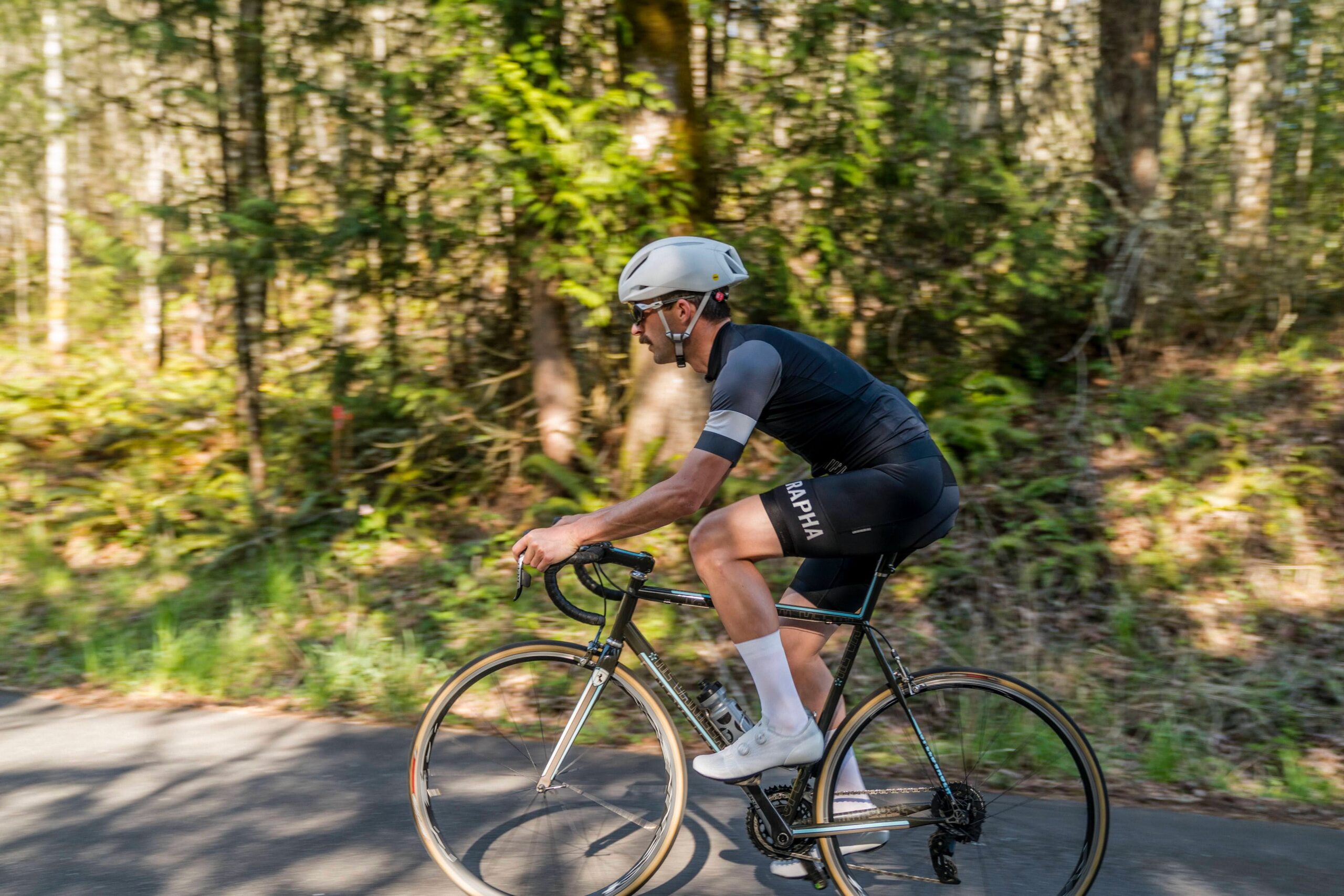
Giro Cadet
Specs
- MSRP $165
- Weight 265g (size 44)
- UpperMaterial Synchwire with thermo-bonded exo-structure
- Outsole Carbon fiber reinforced
- Closure System BOA® L6, velcro strap
- Available Colors White/Black, Black, Harbor Blue, Black/Red
- Available Sizes 39-50
- Cleat Compatibility 3-bolt road and 2-bolt SPD
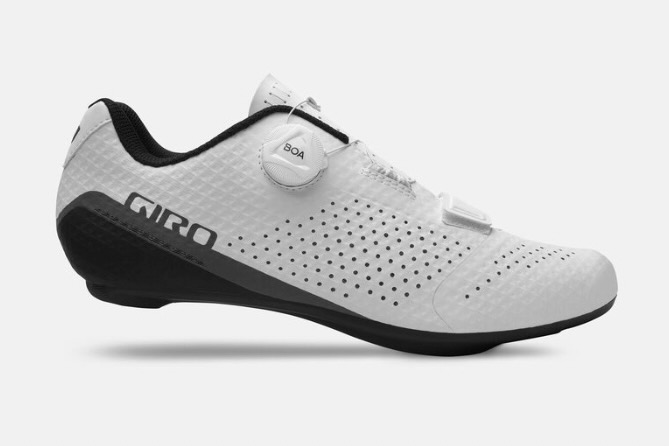
Pros
- Reasonable Price
- Supple upper
- Great fit
- Easy to clean
- Minimal branding
- Compatible with both 3-bolt road and 2-bolt mtb cleats
Cons
- Giro Supernatural insoles and fit kit not included
- BOA dials are 1-way adjustable
- Minimal adjustment range for 3-bolt road cleats
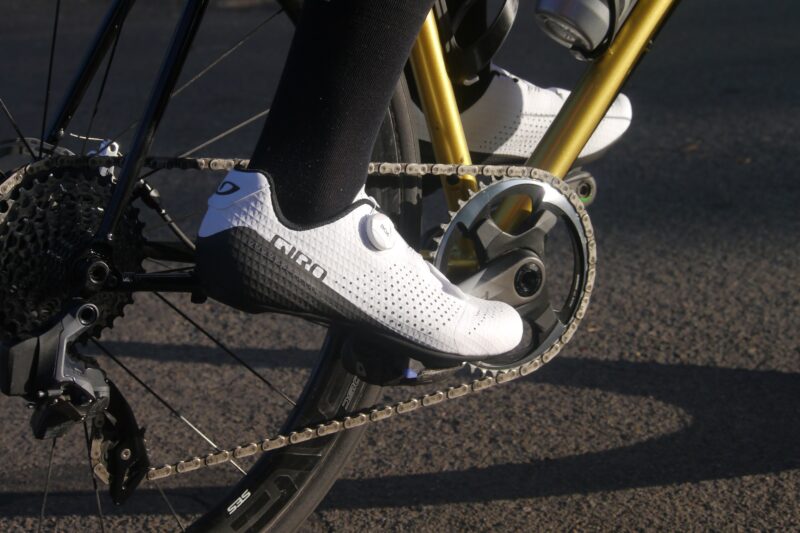
Bontrager Circuit
Specs
- MSRP $145
- Weight 268g (size 42.5)
- Upper Material Synthetic mesh and TPU
- Outsole Nylon composite
- Closure System Boa L6 dial and velcro strap
- Available Colors Black, High Vis Yellow, Nautical Navy/Coral
- Available Sizes Full: 36-48, Half: 38-46
- Cleat Compatibility 3-bolt road and 2-bolt mountain
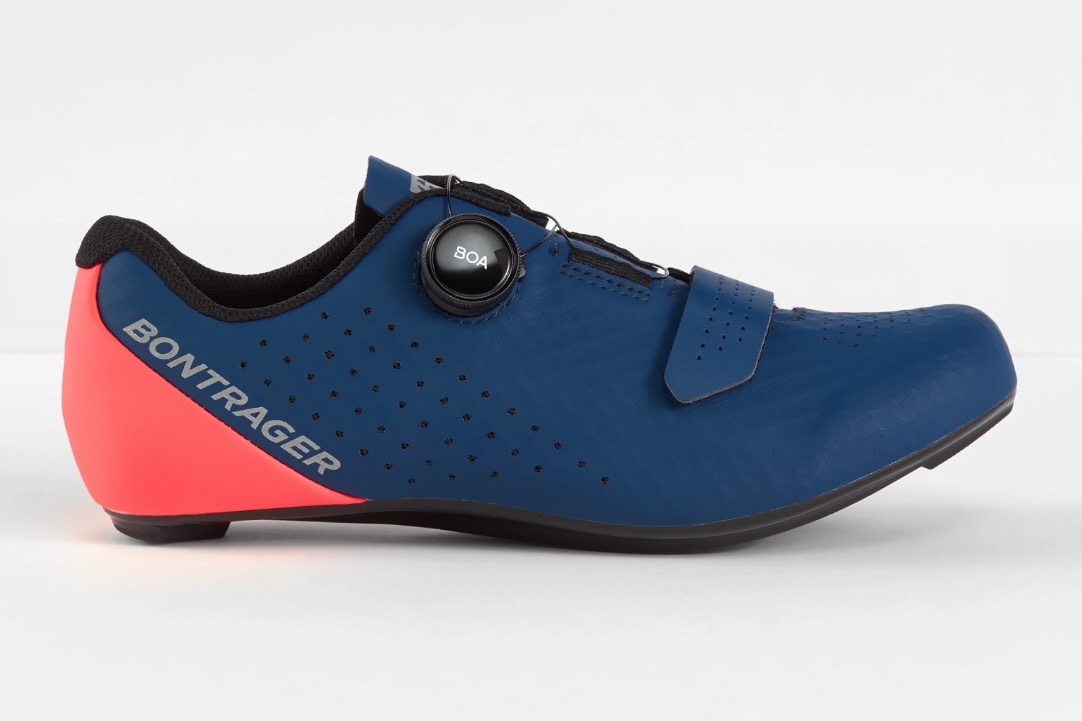
Pros
- Reasonable price
- Comfortable
- Compatible with 3-bolt and 2-bolt cleats
- Perform above asking price
Cons
- Roomier fit in the forefoot (might be a pro for some people)
- Doesn't come with 2-bolt cleat plate
- Middling sole stiffness

Specialized S-Works Torch
Specs
- MSRP $450
- Weight 225g (size 42)
- Upper Material Synthetic
- Outsole Carbon fiber with internal "I-Beam"
- Closure System BOA S3 Snap-fit
- Available Colors Black, White, White Team, Fiery Red, Oak Green, Deep Marine
- Available Sizes Full: 36-49, Half: 38-47
- Cleat Compatibility 3-bolt road
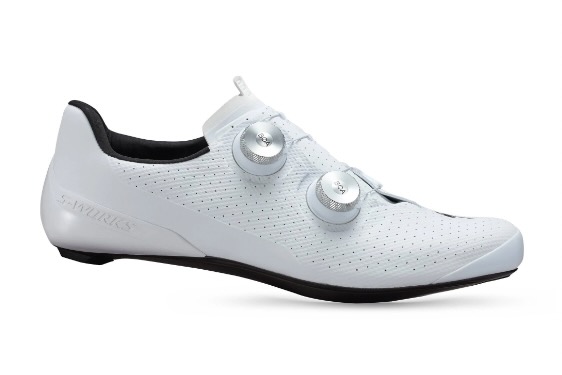
Pros
- Heavenly comfort, especially for wider feet
- More forgiving heel fit
- Low weight
- Outstanding power transfer
- Easy to clean
Cons
- Expensive
- BOA dials don’t pull up for immediate, full release
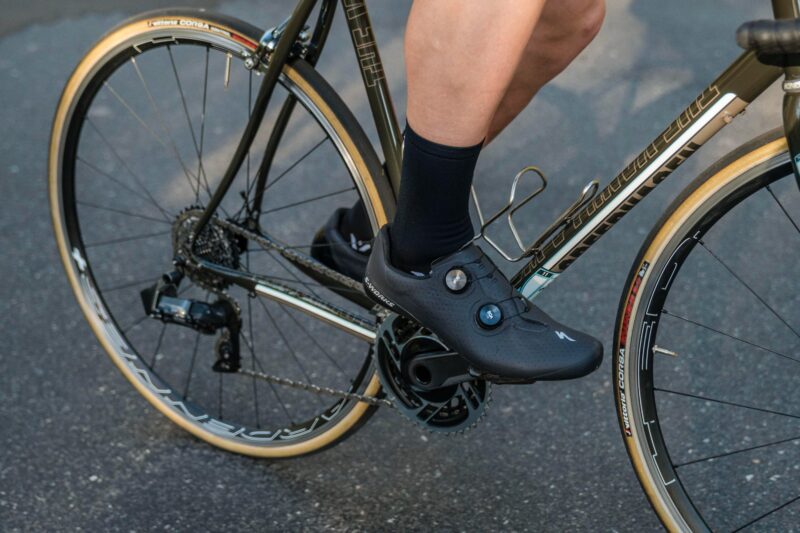
Shimano S-Phyre RC9
Specs
- MSRP $450
- Weight 223g (size 42)
- Upper Material Microfiber synthetic leather
- Outsole Carbon fiber
- Closure System Dual BOA® Li2 dials
- Available Colors Blue, White, Black, Red
- Available Sizes Full: 38-48, Half: 41-47
- Cleat Compatibility 3-bolt road
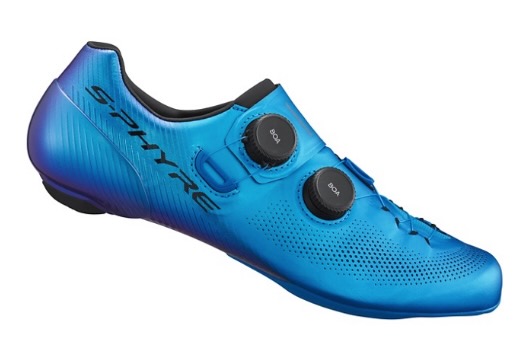
Pros
- Unbeatable efficiency and stability throughout the pedal stroke
- Ample breathability in the upper
- Adjustable arch support
- Extra fore-aft cleat adjustability
- Excellent ankle clearance
- Built-in tire-rub protection
- Comes in regular and wide versions
Cons
- Narrow fit in regular/D width
- Expensive

Pearl Izumi PRO Air Shoes
Specs
- MSRP $425
- Weight 235g (size 42)
- Upper Material Mesh laminate
- Outsole 1:1 PRO Air Power Plate carbon sole
- Closure System Dual Li2 Boa®
- Available Colors White, Black, Carbon/Mica. Bright red
- Available Sizes Full: 39-48, Half: 41.5-46.5
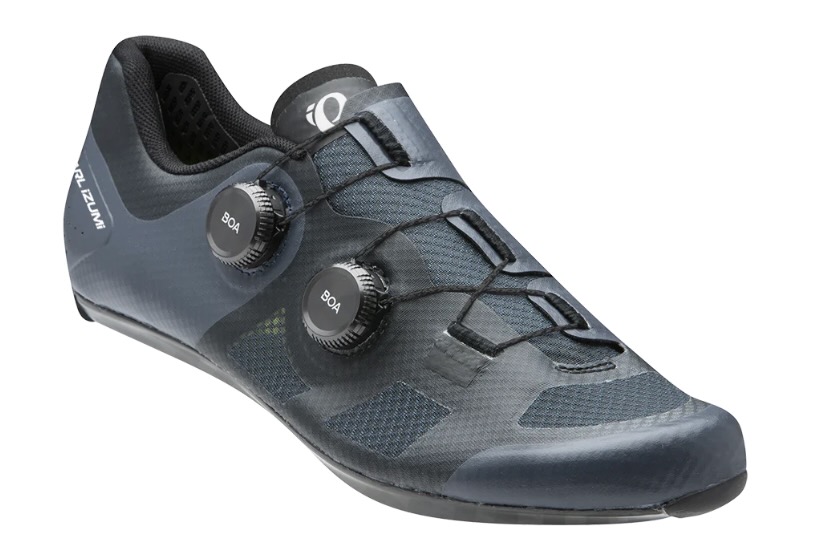
Pros
- Light!
- Supreme ventilation
- Accommodating upper
- Super stiff sole
- Minimal branding
- Lifetime warranty
Cons
- Not ideal for cold climates
- No adjustability in arch support
- Expensive
- One color option
Rapha Classic
Specs
- MSRP $260
- Weight 250g (size 42)
- Upper Material Microfiber
- Outsole Carbon fiber with TPU Cover
- Closure System Double Wall Lacing and velcro strap
- Available Colors White, Black, Stone, Dark Gray
- Available Sizes Full: 36-47, Half: 40-46
- Cleat Compatibility 3-bolt road
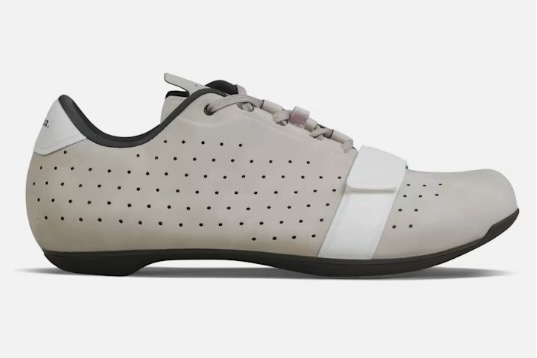
Pros
- Luxurious fit
- Rugged construction
- Excellent walkability
- Classy looks
- Affordable
Cons
- Runs big
- Not particularly light for a lace-up
- Ventilation insufficient for the hottest weather
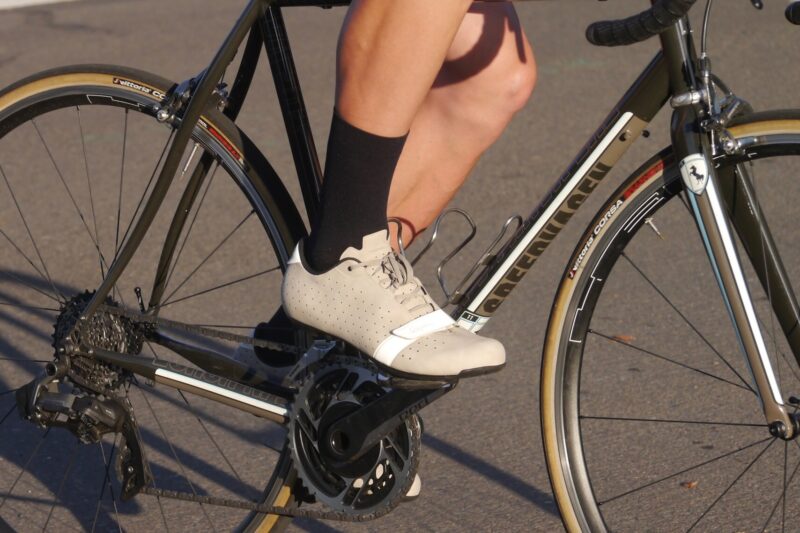
Best of the Rest
Giro Imperial
Specs
- MSRP $425
- Weight 215g (size 42)
- Upper Material Nanofilament Synchwire mesh
- Outsole Easton EC90 SLX2 carbon plate
- Closure System Dual IP-1 Boa®
- Available Colors White, Black, Carbon/Mica, Bright Red
- Available Sizes Full: 39-48, Half: 42.5-45.5
- Cleat Compatibility 3-bolt road
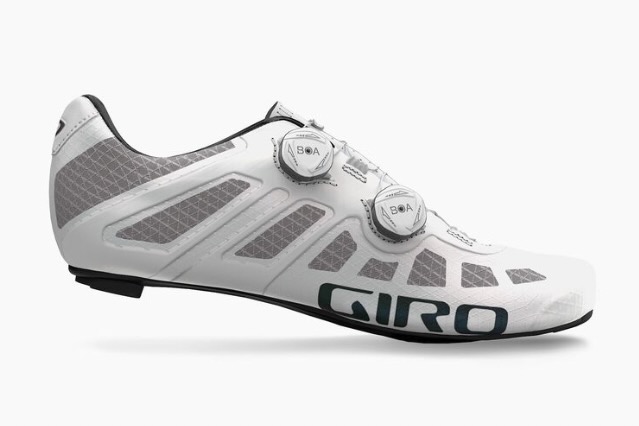
Pros
- Light!
- Supreme ventilation
- Accommodating upper
- Super stiff sole
- Easy-to-adjust arch support
- 60-day comfort guarantee
Cons
- Expensive
- Some reports of soles and Boas breaking in consumer reviews
Fizik Vento Stabilita Carbon
Specs
- MSRP $400
- Weight 227g (size 42)
- Upper PU Laminated mesh
- Outsole Carbon fiber
- Adjustment System Li2 Dual Zone BOA®
- Available Colors White/Black, Black/Yellow Fluo, Silver/Black
- Available Sizes Full: 36-48, Half: 37-47
- Cleat Compatibility 3-bolt road

Pros
- Adjustable plantar support
- Uber stiff soles
- Easy to clean laminated upper
- Minimal branding
- Ample cleat adjustability
- Low profile for sleek looks and aerodynamics
Cons
- Uneven support in mid-sole and inner heel
- Overly stiff tongue
- Water can get in easily around the instep
- Fairly expensive
Sidi Wire 2 Carbon
Specs
- MSRP $500
- Weight 320g (size 44)
- Upper Material Techpro microfiber
- Outsole Vent carbon
- Closure System Sidi Techno Dials
- Available Colors White, Blue, Gray, Black
- Available Sizes Full: 38-48, Half: 38-47
- Cleat Compatibility 3-bolt road
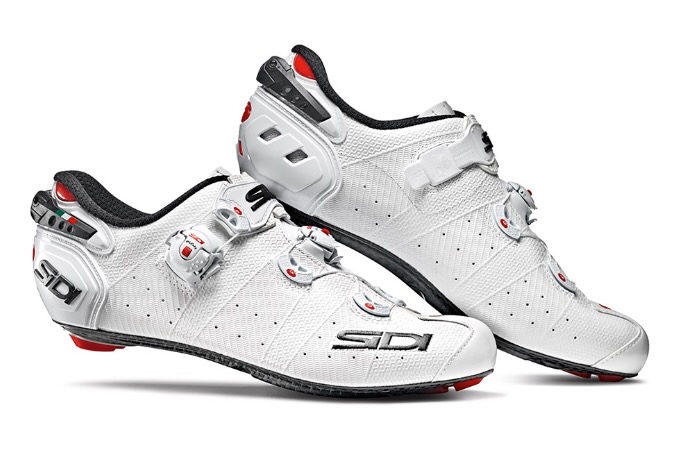
Pros
- Bulletproof, flawless construction
- Adjustable heel cup
- Uber stiff soles
- Replaceable tread bumpers
- Neutral shaping for easy fit
- Small parts are easily replaceable
Cons
- Techno Dials are not as easy to use as BOA
- Expensive
- Heavier weight and heavy branding
Specialized S-Works Ares
Specs
- MSRP $425
- Weight 220g (size 42)
- Upper Material Dyneema, synthetic, and TPU
- Outsole FACT Powerline carbon
- Closure System Dual Boa Li2 dials
- Available Colors White, Team White, Black, Lagoon Blue, Flo Red/Maroon, White/Red
- Available Sizes Full: 36-49, Half: 37-47
- Cleat Compatibility 3-bolt road
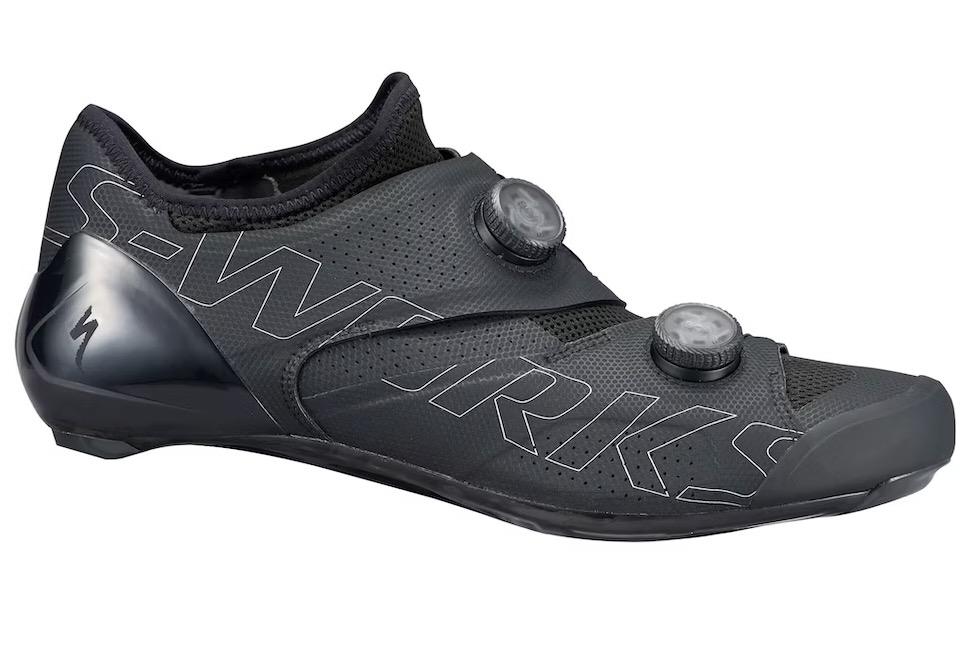
Pros
- Super stiff
- Lightweight
- Very secure fit
- Unique design
Cons
- Expensive
- Roomy fit in toe box
- Took a few rides to figure out the correct closure tension
Giro Empire SLX
Specs
- MSRP $375
- Weight 185g (size 42)
- Upper Synchwire
- Outsole Easton EC90 SLX2 carbon
- Closure System Laces
- Available Colors Black, Gray, White, Blue
- Available Sizes Full: 39-48, Half: 42-46
- Cleat Compatibility 3-bolt road
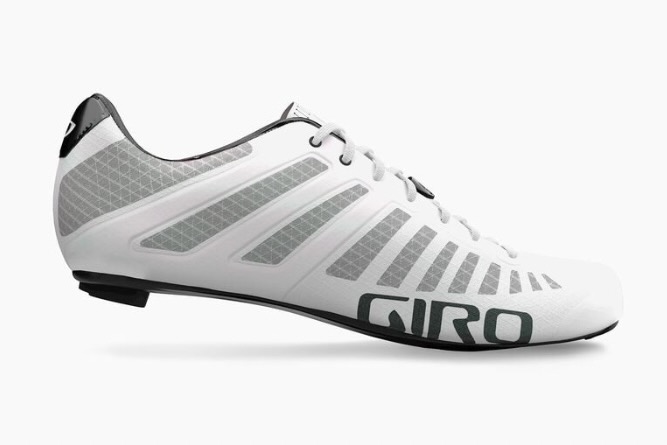
Pros
- Well-executed and easily adjustable arch support
- Supremely supple upper
- Unmatched upper ventilation
- Customizable upper fit, via laces
- Very lightweight
Cons
- Upper so thin and breathable as to be ill-suited to cold weather
- Laces don't allow on the fly adjustment
- Don't feel particulalry durable
- Narrow fit and no wide option
Bontrager XXX Road Cycling Shoe
Specs
- MSRP $420
- Weight 260g (size 42)
- Upper Material 69% Polyester / 28% Polyurethane / 3% Nylon
- Outsole OCLV carbon
- Closure System Dual IP1 Boa® dials
- Available Colors White, Black, White/Navy
- Available Sizes Full: 36-48, Half: 38-45
- Cleat Compatibility 3-bolt road
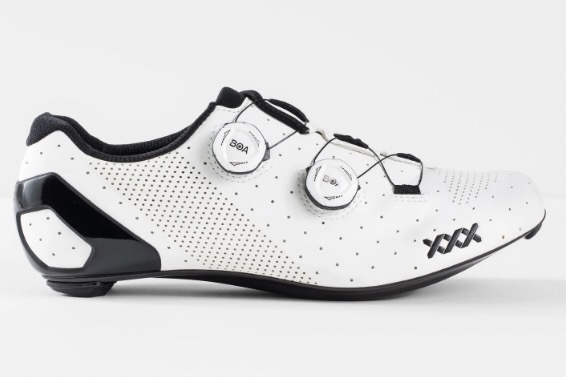
Pros
- Generous fit in the forefoot
- Supple, yet durable upper
- Minimal branding
- Thoughtful ergonomic shaping in heel
- 30-day unconditional comfort guarantee
Cons
- Expensive
- Adjustable arch insoles incur extra cost
- Runs large (we recommend trying them on and possibly downsizing)
Shimano RC5
Specs
- MSRP $170
- Weight 241g (size 42)
- Upper Material Synthetic leather and TPU mesh
- Outsole Carbon reinforced nylon w/TPU cover
- Closure System Boa L6 dial and velcro strap
- Available Colors Black
- Available Sizes Full: 40-48
- Cleat Compatibility 3-bolt road

Pros
- Reasonable price
- Available and regular and wide versions
- High end looks
- Good ventilation
Cons
- Only offered in full EU sizes
- Middle of the road fit and performance
Comparison Chart
| Road Bike Shoe | MSRP | Weight (per shoe) | Outsole | Closure System | Cleat Compatibility |
|---|---|---|---|---|---|
| Rapha Pro Team | $380 | 250g (size 42) | Carbon fiber | Dual Boa Li2 | 3-bolt road |
| Giro Cadet | $165 | 265g (size 44) | Carbon fiber reinforced | Boa L6 and velcro strap | 3-bolt road and 2-bolt mountain |
| Bontrager Circuit | $145 | 268g (size 42.5) | Nylon composite | Boa L6 dial and velcro strap | 3-bolt road and 2-bolt mountain |
| Specialized S-Works Torch | $450 | 225g (size 42) | Carbon fiber | Dual Boa S3 Snap-fit | 3-bolt road |
| Shimano S-Phyre RC9 | $450 | 223g (size 42) | Carbon fiber | Dual Boa Li2 | 3-bolt road |
| Pearl Izumi PRO Air | $425 | 235g (size 42) | Carbon Fiber | Dual Boa Li2 | 3-bolt road |
| Rapha Classic | $260 | 250g (size 42) | Carbon fiber reinforced nylon | Laces and velcro strap | 3-bolt road |
| Giro Imperial | $425 | 215g (size 42) | Easton EC90 SLX2 carbon plate | Dual Boa IP-1 | 3-bolt road |
| Fizik Vento Stabilita Carbon | $400 | 227g (size 42) | Carbon fiber | Dual Boa Li2 | 3-bolt road |
| Sidi Wire 2 Carbon | $500 | 320g (size 44) | Vent carbon | Sidi Techno dials | 3-bolt road |
| Specialized S-Works Ares | $425 | 220g (size 42) | Fact Powerline carbon | Bual Boa Li2 | 3-bolt road |
| Giro Empire SLX | $375 | 185g (size 42) | Carbon fiber | Laces | 3-bolt road |
| Bontrager XXX | $420 | 260g (size 42) | Carbon fiber | Dual Boa IP1 | 3-bolt road |
| Shimano RC5 | $170 | 241g (size 42) | Carbon fiber reinforced nylon | Boa L6 dial and velcro strap | 3-bolt road |
Why Should You Trust Bikerumor?
The Bikerumor team has spent over a decade reporting on and testing the latest and greatest cycling products. In fact, we typically know about and get to try new and updated products before they even hit the market. Every model included in this review was tested by our review author or another member of the Bikerumor editorial team.
Our team consists of riders that span the full spectrum of cycling disciplines, with mountain bike, gravel, and road bike specialists. For this buyer’s guide, we recruited review author, Bennet Shane, to test 12 pairs of the best road bike shoes on the market and share his expertise. Bennett lives in Portland, OR, and has spent the better part of the past two decades grinding out long miles on his road bike while working for a number of prominent brands in the cycling industry. After a decade of racing road and gravel, Bennett has shifted his focus to riding for fun and fitness, and his family. His experience as a cyclist and working in the industry have helped develop his knowledge and understanding of gear and technologies and given him a keen sense of what makes a great road bike shoe along with the ability to tease out the subtle performance differences between the products he tests. Bennett has also tested and reviewed the best road bike pedals, and road bike helmets if you’re searching for a new lid, the best cycling bib shorts if you’re looking to upgrade your riding kit, and cycling shoe covers if you’re looking to keep your feet warm and dry while extending your outdoor riding season.
After researching the best road bike shoe models on the market, we selected a diverse group of 14 models for real-world testing and comparison. After closely examining the materials, construction, closures, fit, and features, each shoe was fitted with 3-bolts road cleats and taken out for real-world testing. Each shoe was taken out for numerous test rides of various lengths to get a feel for how they perform when the rubber hits the road. Important considerations like fit, comfort, power transfer, and ventilation were taken into account to narrow in on our favorite models and those that excel in specific areas. We present those findings here.

Buyer’s Guide: How to Choose Road Bike Shoes
There’s a lot to consider when searching for the best road bike shoes. What type of riding are you doing? What performance characteristics are most important to you? How much are you willing to spend? When considered all together, the answers to those questions should help you narrow it down to the right shoe to meet your needs and budget. One of the most important things, and we can’t stress this enough, is to get a pair of shoes that fits well. Another important factor is having a quality pair of road bike pedals to complete the system and connection between you and your drivetrain. If you’re in the market for mountain bike shoes, we’ve got a comprehensive review of the best mountain bike shoes as well.
Finding the Right Fit
Getting a pair of road biking shoes that fit properly is essential for both comfort and performance. Shoes that fit well will provide all-day comfort and a more secure hold of the foot that results in better stability, control, and power transfer. Cycling shoes come in a range of sizes, with most being measured in EU sizes ranging between approximately 38 to 48 for adults, give or take. Most are also offered in half sizes for the majority of their size range to facilitate a better fit right out of the box. If you don’t know your size, you can check other pairs of shoes you have for reference, or head into a shop and get measured. Most bike shoes are designed with Euro sizing in mind, then US shoe size values are assigned to them. Not every brand does those calculations the same, either, so the European measurement is almost always more accurate. Like any other footwear, it’s often best to try shoes on before you buy to make sure they fit properly in length, width, and overall volume.

When trying shoes on, always wear your cycling socks because sock thickness can skew a shoe’s fit significantly. It is also worth noting that most shoes will feel tightest when they are brand new, and they will break in over the course of the first few rides. Most shoes come in a “regular” width that is intended to fit those with average-width feet, which is the majority of riders. Shoes for road cycling are intended to be snug and fit precisely around the feet and they are often low-volume as a result. Thankfully, a few brands offer wide versions of select shoes for people with wider feet.
When trying on shoes, four key areas to judge are the toe box, arch support, ankle opening, and heel cup. In the toe box, there must be enough space for the toes and forefoot to spread out freely. This space must be adjustable, however, to ensure that there is no excessive movement of the forefoot. Generally speaking, if you feel like you don’t need to adjust the shoe to remove some volume from the front of the shoe after you’ve put it on, the shoe is likely too small in size, or too narrow. Likewise, if you can’t get the shoe tight enough around the forefoot, it is probably too wide or high volume.

The arch support is a raised portion of the insole that cradles the arch of your foot, preventing it from collapsing under force from your pedal stroke. This support should feel natural and evenly dispersed along the inboard side of the shoe. Standing on one leg is a great way to test whether the arch support is sufficient and located correctly for your foot. Some shoe feature insoles with adjustable arch support, and many serious riders will put aftermarket insoles or custom orthotics in their shoes to really dial in the fit perfectly.
Ankle mobility is important to a comfortable and efficient pedal stroke, so ensure that the shoe’s opening is cut low enough so as to not interfere with your ankle joint and Achilles tendon. This also helps to prevent hot spots and abrasion that can cause discomfort over the course of a ride. Lastly, the heel must be held tightly in place, without any slipping that will cause your heel to rise up excessively during intense pedaling.

Upper Materials
Road bike shoes are made with a number of different materials for their uppers. Synthetic leather, or microfiber, is one of the most common and often features mesh panels or perforations for breathability. Microfiber uppers can be somewhat stiff initially and require a few rides to conform to your feet, while others are soft and supple right out of the box.
As material and construction technologies advance, knit uppers are becoming more popular among road bike shoes. Knit uppers generally provide a supple, sock-like fit and are often more air-permeable than microfiber. Other brands employ different materials like Giro’s Synchwire in the Giro Empire SLX, which aims to have a supportive structure while allowing air to pass through to keep the feet cool. Similarly, some models feature PU (polyurethane) coated or laminated mesh which intends to work in much the same way.

Closure Systems
Closures and adjustments are important because they perform the important task of snugging the uppers around your feet. Closure systems for road shoes have been consolidated into three technologies recently; laces, velcro, and BOA ratcheting dials. BOA systems make for quick entry and exit and allow easy and safe micro-adjustment of tension in specific areas of the foot during your ride. Laces are the simplest of all but have a devout following, as they allow for a truly custom fit across the top of the foot, save some weight, are easily replaced, and look smart. Velcro can still be found on many entry-level shoes and is often used in combination with Boa dials. It does the job of securing the shoe without fuss while sacrificing the micro-adjustability of BOA and laces.
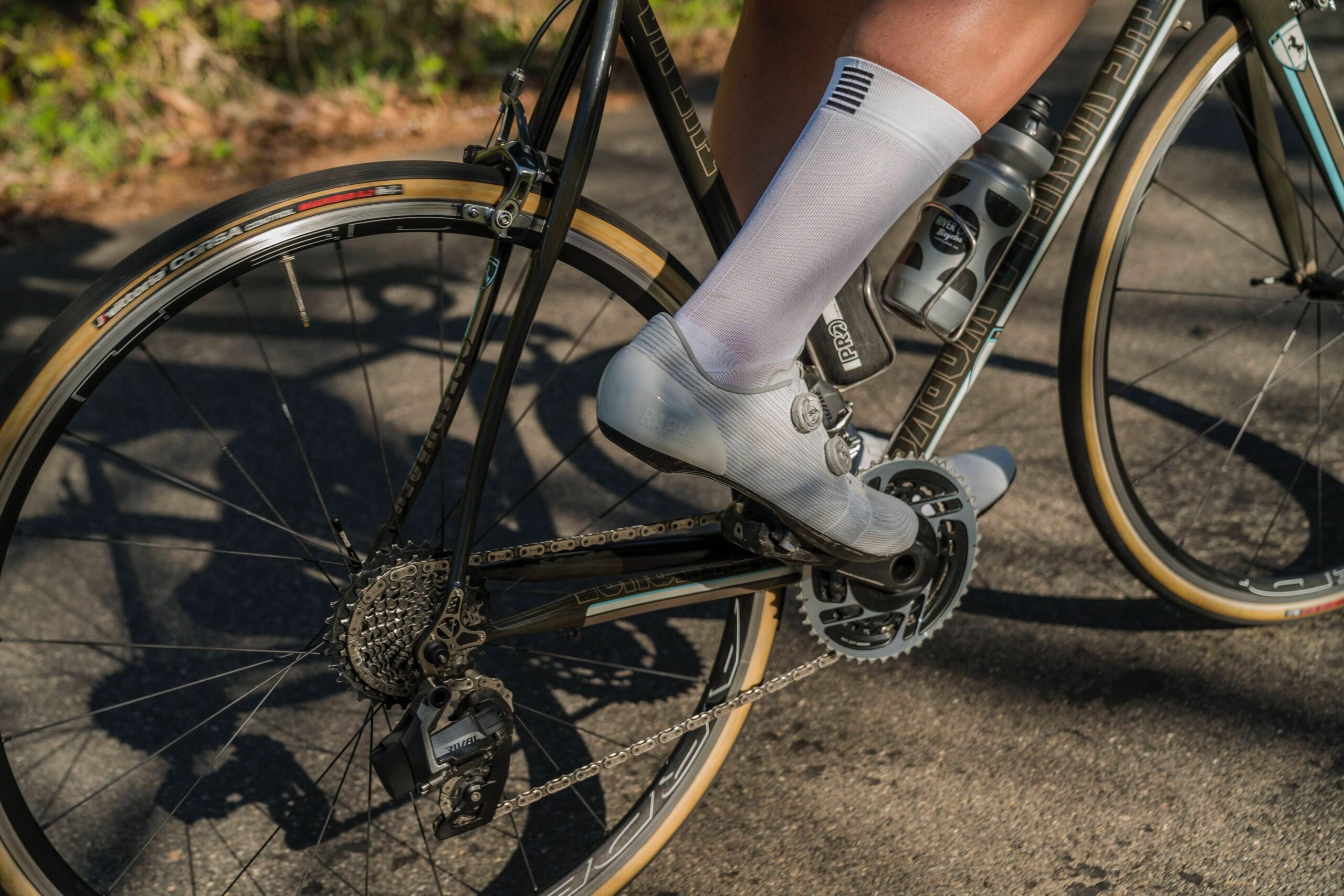
Stiffness and Power Transfer
Sole stiffness is a much-discussed aspect of shoe design and can vary in importance depending on the type of riding you are doing. A road bike shoe’s sole stiffness is directly related to its ability to transfer your pedaling power into the pedals, but it needs to be paired with a precise fit. Racers and riders concerned with maximizing their efficiency on the bike will generally seek a very stiff sole that doesn’t flex under hard efforts. This ensures that all of your precious watts go straight into the pedals without any energy lost through sole flex. More casual or recreational riders may not need or want this extreme level of sole stiffness, and might even be happier with a slightly more forgiving sole design.
The same thing that makes the sole ultra-stiff, specifically carbon fiber, also makes it very thin, and that means that less energy is lost between your foot and the spindle of your pedal. It’s not a torsional stiffness the way we think of a bike frame having in the bottom bracket and chainstay, but rather a strength that allows the sole to remain stiff while being wafer-thin. These thin soles keep your feet closer to the pedal spindle for stability and reduce the chances of rocking laterally which can reduce efficiency. Most road cycling cleats are also wide and provide lots of surface area to further enhance stability.
Still, the right fit is essential in the power transfer equation, as excessive foot movement within the shoe can hinder your pedaling efficiency. This is true on the downstroke when pedaling, but also on the upstroke. A well-fitting shoe holds the foot securely so that there is no heel lift or other slop within the shoe that may allow for loss of energy while pulling up on the pedals. Likewise, proper cleat placement and a good bike fit are also critical to long-term comfort, preventing injury, and getting the most out of your pedal stroke.
As you come down in price and performance levels, soles are often constructed from nylon fiber or carbon-reinforced plastic. These outsole designs are typically less stiff and slightly heavier than their carbon fiber counterparts. Bear in mind, however, that a well-fitting shoe with a slightly thicker and more flexible sole will provide better stability and efficiency than an ill-fitting shoe with a hyper-stiff sole.
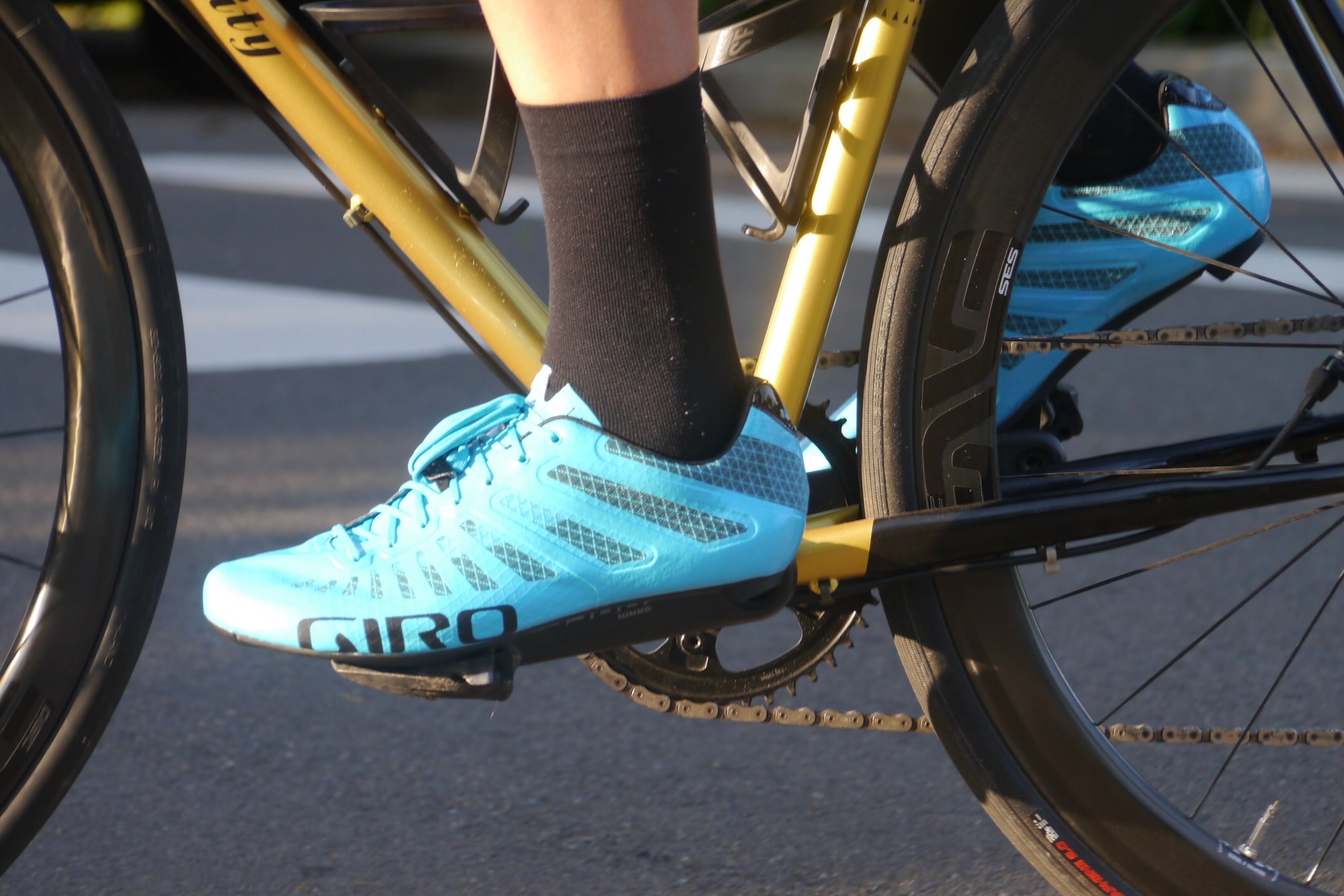
Ventilation
How well your shoes breathe and ventilate your feet is a concern for many riders, but especially those who live and ride in the heat. Upper and sole ventilation can be tricky for riders living in temperate climates, as they rarely see conditions hot enough to warrant the amount of ventilation built into the soles of many higher-end road shoes, and more frequently ride in temps where it can be challenging to keep toes from feeling cold or even worse, losing all feeling. Consider your need for warmth just as much as your need for ventilation. If keeping your feet warm is a priority for cool weather riding in the fall, winter, and spring, a good set of cycling shoe covers might be a worthwhile investment.
Ventilation varies among the models we tested and the materials used in their constructions. Microfiber uppers usually feature perforations in the material above the toes and along the side to allow air to pass through and heat and moisture to escape. These days, most microfiber uppers are able to balance ventilation and insulation duties to keep the feet comfortable in a wide temperature range. As a result, most brands have moved away from upper materials that are specifically chosen for their ability to cope with extreme heat, with many designating their shoes with knit uppers as the best choice for hot days. Knit uppers and other designs like Synchwire and laminated mesh, typically have the best ventilation. Some of the best venitalted shoes we tested are the Pearl Izumi PRO Air, the Giro Empire SLX, and the Giro Imperial.

Sole ventilation is another consideration as many brands have vents incorporated into the soles of the shoes near the toes and/or heels. This allows for some direct airflow to the soles of the feet in areas that can be prone to overheating. These ventilation features typically need to be combined with insoles that have matching holes for them to be effective. Sole ventilation may not be necessary for those riding in cooler climates but may be very important for those who ride in the heat.
In the cooler months or when riding in inclement weather, it is often necessary to wear toe covers or full shoe covers to keep the feet warm and dry. Thankfully there are lots of options, many of which are quite affordable too.
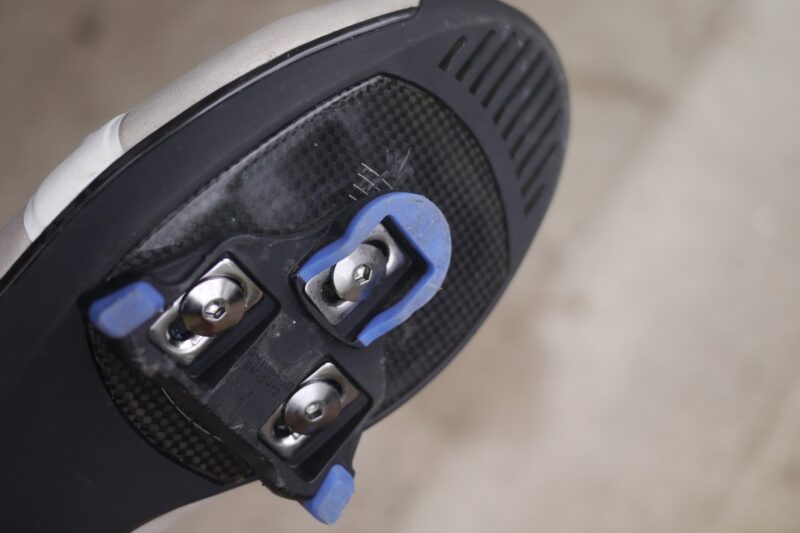
Pedal and Cleat Compatibility
In combination with shoes, you’ll need to choose a pedal system, and those pedals will include the appropriate cleat which you’ll then mount to the sole of your shoes. While they function similarly, road cycling pedals are different from their mountain bike counterparts both in pedal design and the cleats that go with them. Look, Shimano, and Time pedals all have similar, but not cross-compatible, cleats that are fairly large and have a triangular 3-bolt pattern. This 3-bolt pattern is standard among road-specific cycling shoes. Speedplay pedals use a distinct cleat design that includes an adapter for use with all 3-bolt road shoes. Some shoes, generally less expensive, are drilled with both the triangular 3-bolt road cleat pattern as well as the side-by-side “spd” or 2-bolt mountain bike cleat pattern to give you more choices in the pedal and cleat you can use.
Among road cyclists, Shimano and Look pedals are the most popular with Time and Speedplay taking a smaller percentage of the market share. While road shoes and cleats do not allow for a natural gait when walking and can be awkward and slippery at times, the pedal/shoe interface is significantly larger, and this yields better efficiency and comfort, especially with regard to preventing hot spots on the sole of the foot, above the pedal spindle. Still, many road riders love to use “spd” mountain bike pedals along with mountain biking, gravel, or touring shoes because the rubber tread on the outsole of the shoes makes walking much easier and more natural. If you don’t plan to spend much time standing or walking in your riding shoes, we strongly recommend dedicated road shoes for road riding.

Style
Road cycling shoes remain quite traditional, so most of the choice here comes down to color. White and Black are always safe choices, however, many brands also offer vibrant options that stand out from the crowd, as well as earthy colors that create a classy and understated look. Consider the amount of branding you want on display, as well as how clean you like to keep your shoes, as more minimal designs tend to clean up more easily and avoid looking dated after a few years.
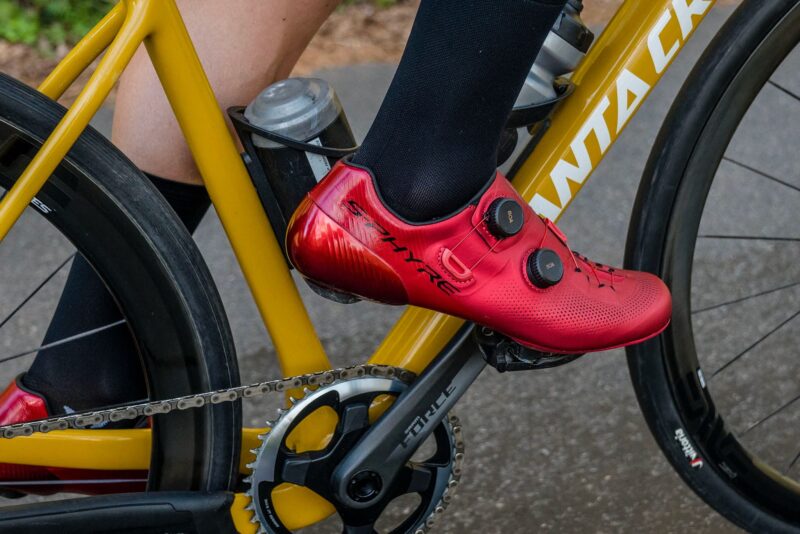
Value
The prices of high-end shoes have increased steadily, nearly doubling those of a decade ago in some cases, so it’s fair to ask what benefit you’re getting from $400 shoes that you won’t find in $150 shoes. After all, the most important aspect of any shoe is the fit, and extra features will not correct a poor fit. That said, higher-end shoes – aside from being lighter, stiffer, and easier to adjust – consistently fit better out of the box, and provide exceptional comfort on long rides than their less expensive counterparts. So it’s likely that whatever style of riding you do – whether road racing, taking on challenging endurance rides, or just riding purely for fun – you will be able to find a great fit at the high end of the market.
Racers and more demanding endurance riders, who regularly ride over 15 hours per week and are keen to maximize their performance, will benefit from the characteristics and advanced features of higher-end shoes. These include ultralight weight thanks to premium materials, increased efficiency and stability by way of wafer-thin carbon soles, and the ability to perfect the fit with advanced closure systems like the BOA dials. When you consider the time and volume of pedal strokes these riders rack up on the bike, cost becomes less of a concern than absolute comfort and maximum efficiency.
For recreational riders who are new to the sport of cycling or don’t expect to spend as much time riding, it’s sensible to try on less expensive road cycling shoes, as they can dutifully execute the task of securing the foot to the pedals, providing stability, efficiency, and comfort, so long as they are the correct fit. Furthermore, many brands transfer technology found on their range-topping models down to the mid-tier shoes in their lineups, using different materials to keep the cost more reasonable.
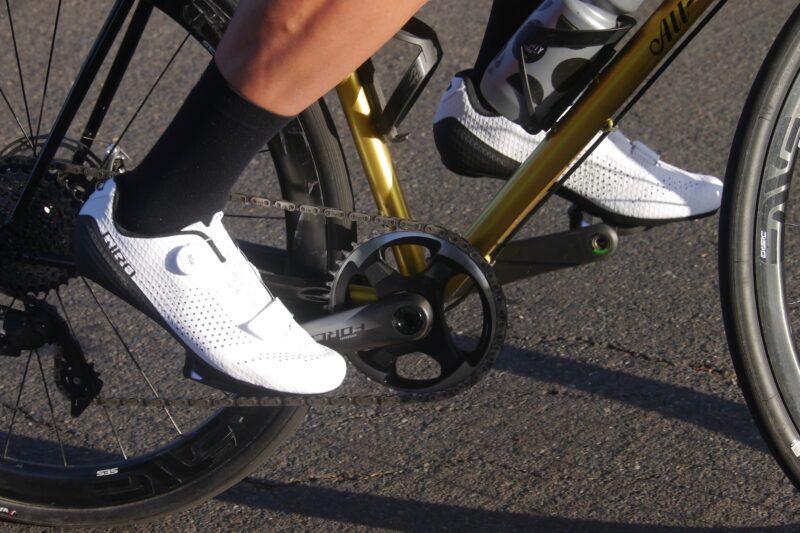
Frequently Asked Questions
While you can ride a road bike in just about any shoes you choose, road bike shoes are designed specifically for that purpose and are the best option. When paired with road bike pedals, they provide a great connection and excellent power transfer for enhanced efficiency. They are not only lightweight and stiff, but they have streamlined designs that help reduce drag over long hours in the saddle.
Of course. It depends on the model and your performance expectations, but gravel or mountain bike shoes are a reasonable alternative to road bike shoes and are preferred by many people because they are generally a bit easier to walk in than road bike shoes. In fact, many high-end cross-country shoes are very similar in stiffness and weight to their road bike counterparts, just with some additional rubber tread added to the soles for walking traction. The right pair of shoes could cover all of your bases for road, gravel, and mtb riding. Both mountain and gravel shoes usually have 2-bolt patterns in their soles, however, so you’ll obviously need to be sure to use pedals with 2-bolt cleats on your road bike as well.
Road bike shoes vary pretty dramatically in price between entry-level models and top-of-the-line racing shoes. The biggest differences are typically in the materials used, with more expensive models featuring full carbon soles and fancier closure systems. There’s also quite a lot of research and development that goes into them, so you end up paying a premium for the latest and greatest technology and designs. Lower-priced shoes typically offer slightly lower performance in specific areas, though they are still generally adequate for more casual, recreational riders.
How much you should spend depends on your budget and your needs. If you’re a racer looking to eke out every watt of power on the race course, then you’ll probably find the marginal gains offered by the most expensive, race-oriented shoes to be worth the premium price tag. Most serious non-racing cyclists will probably find the most value from shoes that are a step down from the top-tier models with little reduction in all-around performance. Casual riders with no competitive aspirations don’t need to spend the big bucks for the fanciest shoes out there and will likely be just as pleased with less expensive shoes and saving a couple hundred dollars.
While many shoes are unisex, many brands make women’s versions of their road cycling shoes. Of course, anyone can wear any shoes that fit them properly, but some women’s shoes have been adapted slightly to better fit a woman’s foot shape. Women’s versions of cycling shoes tend to be a bit narrower in the heel, and they come in smaller sizes compared to men’s. Colors are often a differentiating factor, and women’s shoes are sometimes available in different, “more feminine”, colorways.
Related Content
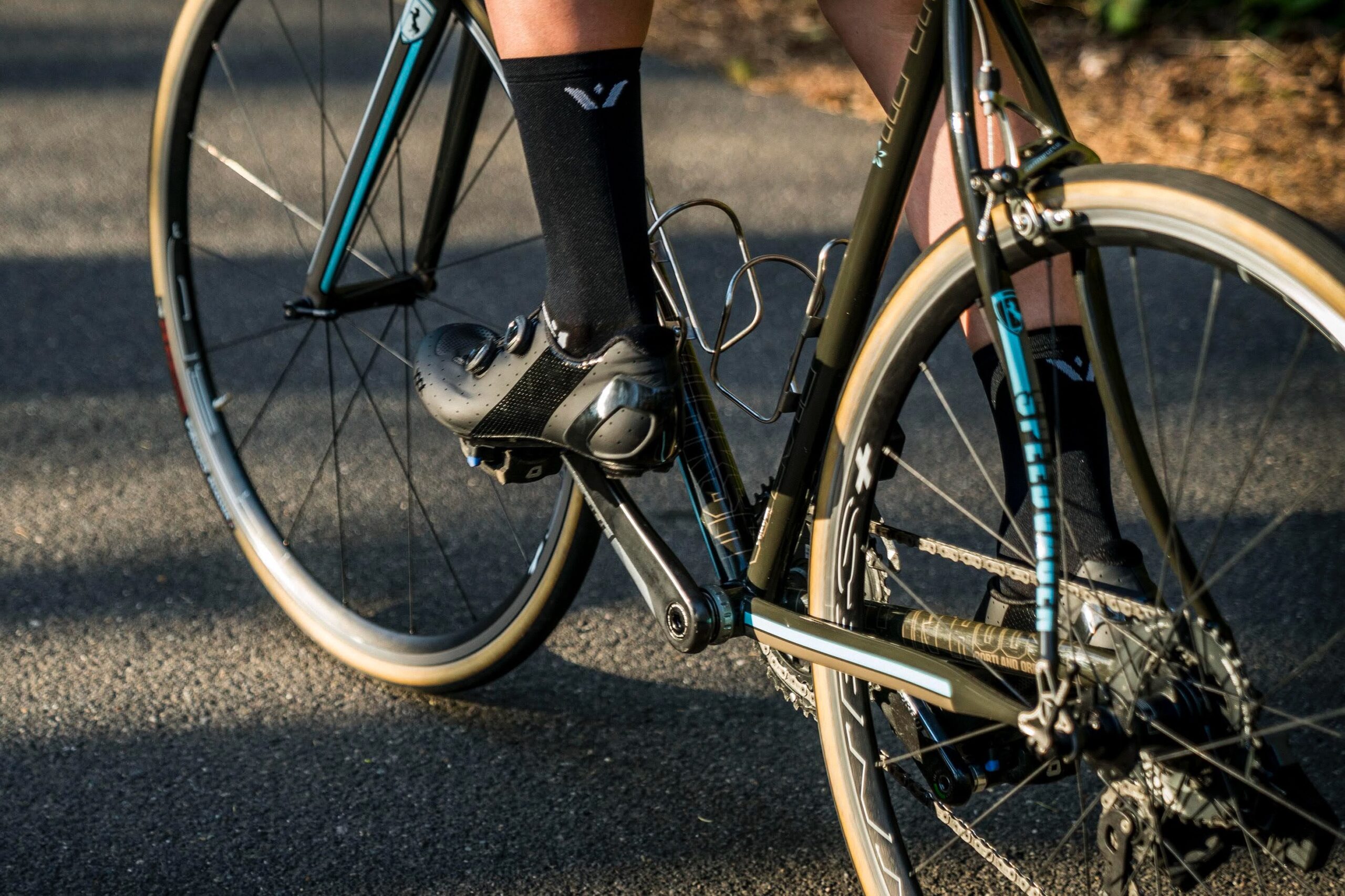
The Best Road Bike Pedals of 2023
If you are a road cyclist, finding the right pair of road bike pedals can enhance your efficiency and comfort on the bike. This seemingly…
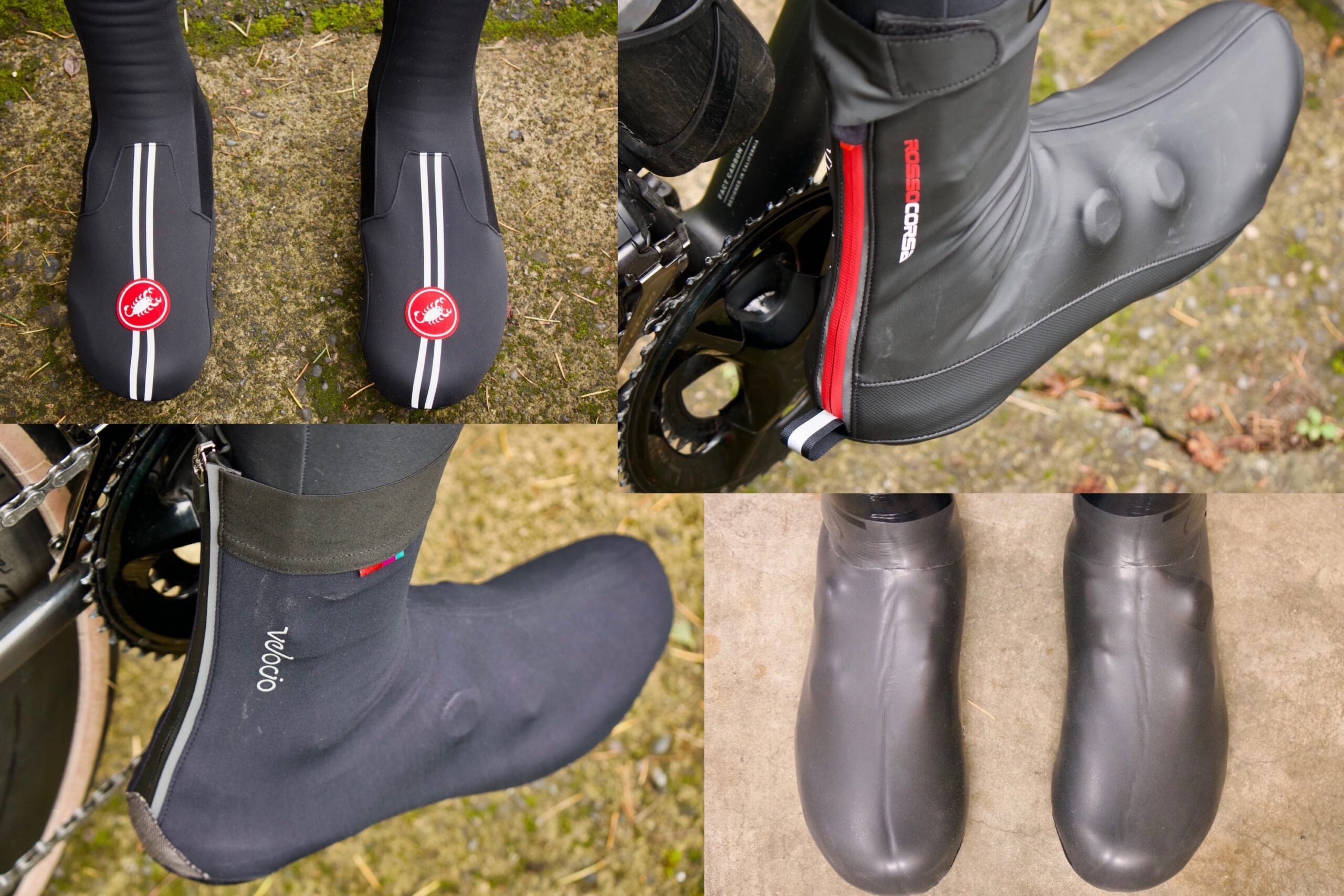
The Best Cycling Shoe Covers of 2024
Without proper protection, water, wind, and cold air will conspire to punish your feet and cut your ride short. Keeping your extremities, and especially your…

